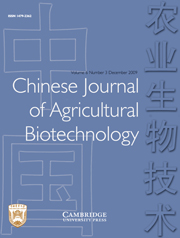Article contents
Regeneration of vgb-transgenic poplar (Populus alba×P. glandulosa) and the primary observation of growth
Published online by Cambridge University Press: 12 February 2007
Abstract
Increasing the growth rate is especially important for low-quality wood applications, so this has become an important goal in poplar breeding. The present study describes the transfer of Vitreoscilla haemoglobin (VHb) gene (vgb) driven by constitutive promoters, by Agrobacterium tumefaciens into poplar (Populus alba×P. glandulosa). From about 450 leaf discs used for transformation, 60 Kan-resistant plants were obtained, and 52 proved to be true transgenic plants. The transgenic nature of these plants was confirmed by polymerase chain reaction (PCR) amplification and Southern dot blot hybridization. The expression of vgb gene in transgenic plants was confirmed by reverse transcriptase-PCR (RT-PCR). The performance of the transgenic lines was evaluated during the first year of growth in a greenhouse. These plants showed no significant stable morphological differences from the untransformed plants. Among them, three vgb-transgenic lines exhibited noticeably higher growth rates in terms of height and diameter.
- Type
- Research Article
- Information
- Copyright
- Copyright © China Agricultural University and Cambridge University Press 2006
References
- 2
- Cited by


